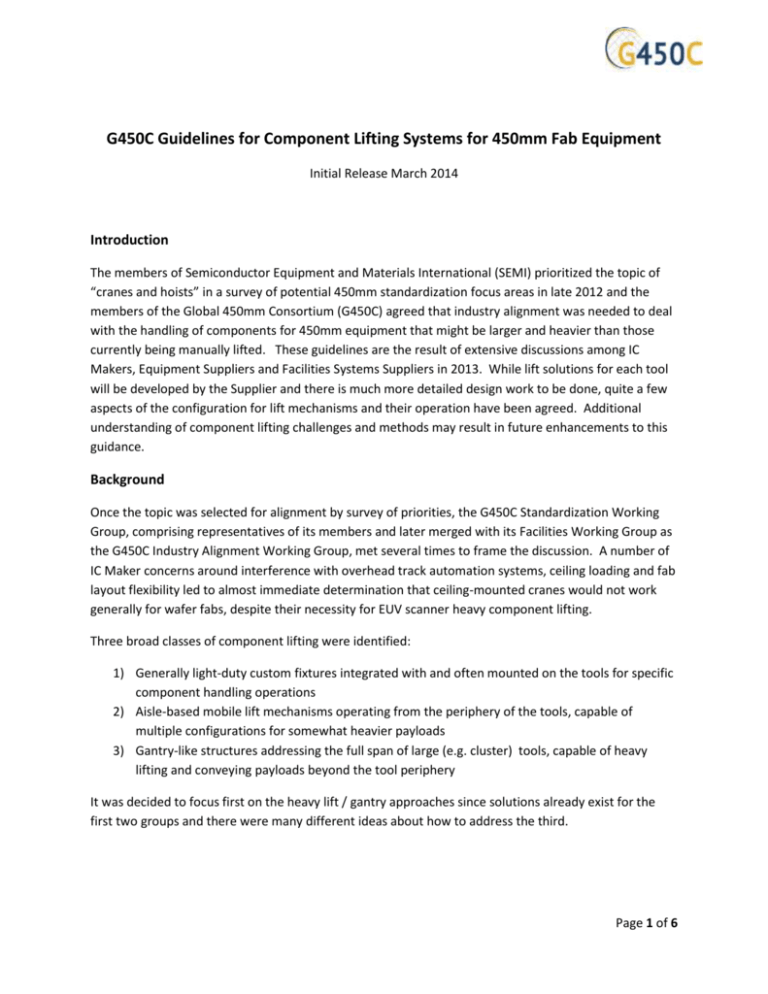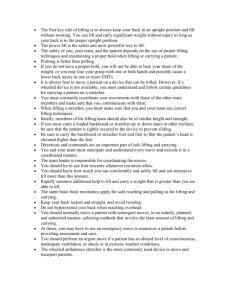G450C0314GLCL
advertisement

G450C Guidelines for Component Lifting Systems for 450mm Fab Equipment Initial Release March 2014 Introduction The members of Semiconductor Equipment and Materials International (SEMI) prioritized the topic of “cranes and hoists” in a survey of potential 450mm standardization focus areas in late 2012 and the members of the Global 450mm Consortium (G450C) agreed that industry alignment was needed to deal with the handling of components for 450mm equipment that might be larger and heavier than those currently being manually lifted. These guidelines are the result of extensive discussions among IC Makers, Equipment Suppliers and Facilities Systems Suppliers in 2013. While lift solutions for each tool will be developed by the Supplier and there is much more detailed design work to be done, quite a few aspects of the configuration for lift mechanisms and their operation have been agreed. Additional understanding of component lifting challenges and methods may result in future enhancements to this guidance. Background Once the topic was selected for alignment by survey of priorities, the G450C Standardization Working Group, comprising representatives of its members and later merged with its Facilities Working Group as the G450C Industry Alignment Working Group, met several times to frame the discussion. A number of IC Maker concerns around interference with overhead track automation systems, ceiling loading and fab layout flexibility led to almost immediate determination that ceiling-mounted cranes would not work generally for wafer fabs, despite their necessity for EUV scanner heavy component lifting. Three broad classes of component lifting were identified: 1) Generally light-duty custom fixtures integrated with and often mounted on the tools for specific component handling operations 2) Aisle-based mobile lift mechanisms operating from the periphery of the tools, capable of multiple configurations for somewhat heavier payloads 3) Gantry-like structures addressing the full span of large (e.g. cluster) tools, capable of heavy lifting and conveying payloads beyond the tool periphery It was decided to focus first on the heavy lift / gantry approaches since solutions already exist for the first two groups and there were many different ideas about how to address the third. Page 1 of 6 Derivation G450C members in consultation with those of the Facilities 450mm Consortium (F450C) agreed to form a Component Lift Task Force, later renamed the Component Lift Working Group to avoid confusion with SEMI Standards Task Forces, to also include Suppliers of large cluster tools interested in the topic and representatives from SEMI. G450C would like to thank the participants of the Working Group for their broad range of ideas, a lot of hard work developing them and analyzing the pros, cons and trade-offs. ASM Applied Materials CH2M Hill College of Nanoscale Science and Engineering GLOBALFOUNDRIES Intel Corporation IBM Lam Research M+W Group Samsung SEMI tsmc Tokyo Electron Todd Dunn Michael Kuchar Jeff Hudgens Alpay Yilmaz David Krick Lawrence Hennessy Carolyn Towle Kevin O’Malley Tom Alfieri Les Marshall Shiv Kumar Bill Corbin Brian Byrne Ted Minshall Miguel Saldana Adrian Maynes Allen Ware Don Yeaman Seok Hee Park Seungun Kim Jonathan Davis James Amano Vincent Chou T. Y. Lee Pinyen Lin Turbo Horiuchi Sensho Kobayashi Supika Mashiro Toshiuki Namba Page 2 of 6 Early Information Gathering A survey of the G450C members resulted in a projected range of dimensions for the 450mm fab structures in which the lifting operations and mechanisms must fit (Table 1). Suppliers were also asked to provide inputs and CH2M Hill, an F450C member fab construction consultant company participating in the discussion, gave typical values based on their experience. Projected Ranges of 450mm Fab Dimensions Table 1 Equipment Suppliers pointed out other constraints under which they had to address the lifting needs, including access to space around tools, exclusion zones and pressure to minimize footprint, as well as costs. They were asked to provide information in confidence on the characteristics of the payloads and motions required in the lifting of components in the context of their tool configurations. It is not possible to share those inputs but they resulted an understanding of the operations that drove many of the guidance points later agreed by the group. Proposed Solutions Tightly Mounted: an integrated gantry spanning the tool was the baseline approach for heavy lifting across large areas. Variations on such structures have been used in prior applications; the group focused on ways to mount them either directly to the tool, onto the cleanroom raised metal floor (RMF) or through the RMF onto the concrete floor. Concerns included lack of standardization, potential to increase footprint and the cost of providing a gantry for every tool requiring heavy component lifting. Hybrid: early on the group looked to create efficiencies by using standardized columns, rails, beams and connectors that could be assembled onto a fixed front arbor in an “erector set” fashion for the operation and then disassembled for re-use at other tools. This approach received a lot of attention for Page 3 of 6 its flexibility, having no permanent footprint and potential for cost savings through multiple uses of common parts, but concerns arose about the security of connections and potential safety exposures of the assembly, as well as the costs of putting them up, taking them down and storing them. The landing of the rear portion of the gantry on the RMF proved a sticking point for some participants. Mobile gantry: resembling two A-frames joined by rails, it could be wheeled into place and thus shared across multiple tools as well; it could be left in place until needed elsewhere but moved if needed, thus avoiding both footprint penalty and dedicated storage space. Such a structure could avoid some of the concerns about assembly / safety / recertification and could be configured for adjustability in span, height and maneuverability in tight aisles. Under-floor Track: by mounting either swing arms or an arbor on rails fixed at or under floor level, the lift support structure could be assembled and moved along the depth of the tool in an inverted gantry. The rails would be mounted onto sub-structure resting on the concrete floor, avoiding concerns of loading the RMF; the area could be clear when not in use and rails could be shared between adjacent tools, thus minimizing footprint impact, but the space above would have to be clear, potentially requiring life safety and facilities access tiles to be located somewhere other than alongside the tools. Tube-in-tube: an array of receiver tubes could be spaced around the fab below floor level and swing arms mounted on tubes to be mounted into them could be deployed as needed and shared across multiple tools. The Tube-in-Tube approach can also be used in combination with others to provide anchoring to the concrete floor with minimal footprint. There were concerns about the fixed receiver tubes interfering with sub-floor space and affecting the load boundary for PGV carrier delivery. Mobile lifter: aisle-based carts for heavy lift applications could also be enabled by stabilizing mechanisms such as bracing attachment to tools (concern on vibration), cantilevered footings and counterweighting or by built-in adjunct mechanisms like sliders to convey the payload outboard of the tool over the aisle, avoiding the need for stabilizing mechanisms on the cart that might require more space. In evaluating the options the group determined a set of criteria, in order of importance: safety, tool performance impact, overall cost, space efficiency and risk of implementation. Given safety and recertification concerns about structures assembled for temporary use, and the fact that they had not been designed or proven, the hybrid and under-floor track options in particular had some resistance. The other factors could be quantified and compared by looking at costs. Cost Considerations The Working Group defined a cost of ownership model to compare the various approaches on an overall basis. Elements comprehended included the capital costs, including any efficiency for multiple use, footprint and storage space required, and operational costs including labor, excess downtime and certification for any assembled approach. The most striking outputs of the cost analysis were how small the costs of these capabilities were compared to the overall fab operation costs and how little difference there was between the approaches. Page 4 of 6 The cost model outputs are summarized in Table 2 and the spreadsheet model is available for anyone wishing to look at different assumptions and inputs, but the bottom line is that cost is not a major differentiating factor in this consideration. Summary of 5-Year Costs for the Various Lift Approaches Cost Element Hybrid Capital Expense Efficiency Factor Storage Cost Footprint Cost Operational Cost $13M 43% $1M $0M $5M Total $12M Tightly Mobile Under Tube in Mobile Mounted Gantry Track Tube Lifter $13M $3M $13M $2M $1M 100% N/A 30% N/A N/A $0M $2M $1M $1M $1M $2M $0M $5M $2M $0M $0M $1M $3M $1M $1M $15M $6M $13M $6M $3M Table 2 Key Requirements Suppliers own designing and providing lift capability integrated with configuration and operations of tools. The IC Makers identified a number of boundary conditions to ensure whatever lift solutions might be designed have minimal impact on other fab operations. Lift mechanisms, like all tools, must be safe to operate and maintain at any stage of maturity, and must comply with applicable SEMI Safety and Ergonomics Standards, regulations and codes Lift solutions as integrated by the Supplier with the tool must conform to SEMI E72, in particular with regard to height restrictions The load cannot be suspended from the ceiling and must be transferred to the concrete floor Guidelines Safety Imperatives: S1: All equipment must be safe to operate and maintain at any stage of maturity S2: Lift mechanism must be engineered to be safe to assemble / operate S3: Must comply with SEMI Safety / Ergonomic Standards and applicable codes and requirements Productivity Imperatives: IC Makers and Suppliers benefit from minimizing cost and maximizing productivity of fab space. Component lift solutions must not affect: P1: Closest packing of tools (minimize space around tools) P2: Layout flexibility (free-span ceilings enable adjustments) P3: Minimal tool down time (efficient component lifting) Page 5 of 6 Design Requirements (in no order): D1: Must comply with SEMI E72 D2: No ceiling mounting D3: Must transfer component weight to concrete floor, e.g. via steel or concrete pedestal, though a tool base is not required D4: Must position components beyond tool periphery for exchange with transport cart without unaided human lifting or lowering D5: Must not impact tool process performance D6: Permanent structure counts as footprint – minimize space beyond tool periphery D7: Not part of the facility – must be able to move with tool D8: Articulating lift mechanisms must be used in cases where insufficient vertical lift space is available D9: Avoid component lift structure recertification upon deployment Other Areas of Agreement: A1: Temporary structures using floor space adjacent to the tool should not interfere with the RMF tiles when the lift mechanisms are not in use (otherwise counts as additional footprint) A2: Minimize impact to flexibility of facilities routing under the RMF A3: No significant impact to airflow in the space under the RMF (part of the cleanroom air return) A4: Methods of fixing load-bearing lift elements to the concrete floor should be minimal in scope and easy to relocate if necessary A5: Where the lift mechanism does not extend beyond the tool periphery, adjunct mechanisms (e.g. slider, rotation fixture with adequate cantilever structure or counter-weight) should be provided to convey the load over transportation cart in aisle A6: While no side-to-side aisle dimension has been agreed, there is resistance to needing more than 1.5 tiles (3’) between tools A7: With respect to adjacent equipment, lift elements or swing arms shall not (even temporarily) compromise exclusion volumes such as OHT chimneys Forward Thinking Given these assessments it is clear that some concepts would require substantially more engineering design and prove-in than others. Mobile lift carts and gantries are in use and will be used for 450mm. One could envision having gantries tightly mounted on those tools that require frequent heavy lifting across a large operating span. For tools with less frequent or limited overhead operations adjunct mechanisms could be included to convey loads to mobile lift carts in the aisles, which can address most peripheral work. For infrequent heavy lifts a mobile gantry might be brought in, e.g. for an annual PM or a chamber change-out. G450C greatly appreciates the industry collaboration that has gone into the understanding of component lifting to date and is open to proposals to prototype lift mechanisms. March 4, 2014 Document Owner: Frank Robertson Page 6 of 6







